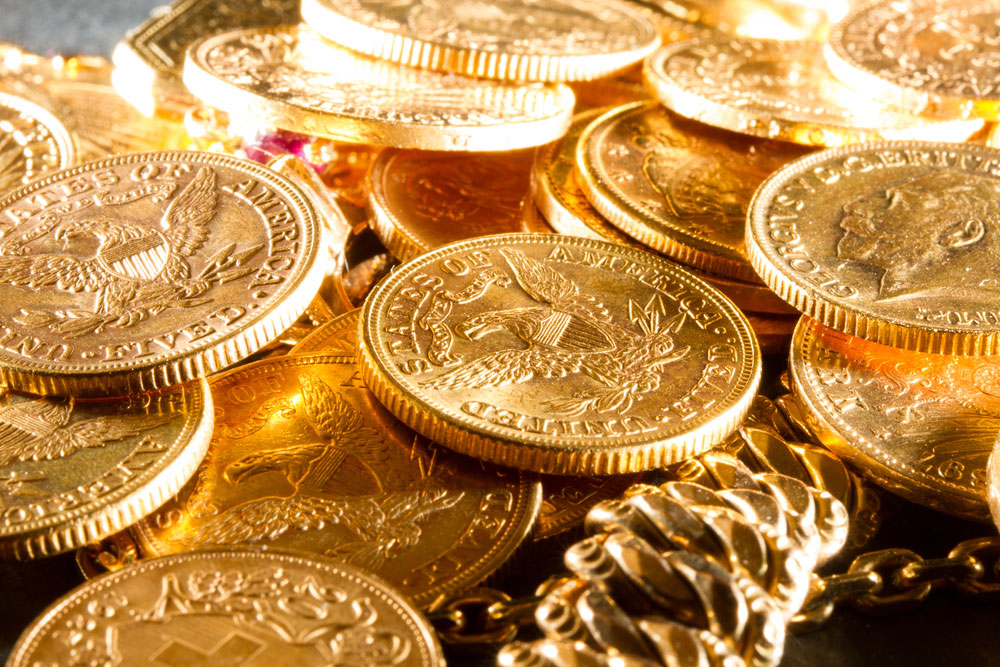Why is gold beating stocks so soundly in this new century? Gold has often soared during America’s darkest hours, during the historic decades of global depression or deep recession – like the 1930s and the 1970s. In fact, gold was one of the only positive investments in those decades. Could we be at the beginning of another such decade in the 2010s? The evidence is in. We haven’t seen this level of continued deep financial concerns since the 1930s. Where we go next in the world economy is anyone’s guess, but a portfolio with a heavy counterweight in gold is the portfolio most likely to survive.

More and more analyst and investment advisers recommend gold as a vital investment. Gold fulfills six primary investment goals, not available in most other investments.
1. Gold as a Diversification Vehicle
Investment advisors often speak of “negative correlation.” In practical terms, that means that a well-protected portfolio must contain investments that “zig” while the global stock markets “zag.” You don’t want all of your investments going down at once, right? Most investors suffered that fate in 2008 and 2009, when all three leading asset classes (stocks, bonds and cash for income) fell at once. That’s why investors need gold to lift a portion of their net worth higher, even while all of their other investments may sink in unison.
God rose strongly during the stock market crashes of 2001-03 and 2007-09. There will likely be times in the future, when all other investments rise and gold falls, but the role of diversification is to offset your losses in both scenarios. Don’t put all of your net worth into gold, or stocks. many investment advisors say that a rational component of gold – depending on your age, risk profile, and income needs – would be 5% to 25% of your total portfolio. Most investors, frankly, have zero gold and are suffering for that fact.
2. Gold as a Natural Hedge Against Inflation
In times of inflation – like 1923 in Germany, or after World War II in Europe, or in the U.S. in the 1970s – gold has soared, fulfilling its role as an inflation hedge. Over 2300 years ago, the Greek philosopher Aristotle laid out the case for gold as a pure form of money – impossible to inflate:
- Gold is durable. It won’t rot. Gold, more than any other solid element, is chemically inert.
- Gold is divisible. One ounce of gold – whether bullion, coin, or dust – is worth exactly the same amount.
- Gold is convenient and mobile. Gold allows its owner to carry his life savings in a small suitcase or money vest: Each $100,000 weighs less than 6 (six) pounds.
- Gold is difficult to find and cannot be created by fiat.
3. Gold as Protection Against a Declining Dollar
The dollar and gold are closely linked, with a “60% inverse correlation” in recent years. In other words, the value of the dollar provides about 60% of the cause for gold’s price changes, up or down. That correlation is up from 53% in 2007, which means that the value of the dollar is the single most important indicator to watch when determining gold’s trend: dollar down = gold up.
The dollar has been in a major bear market since 2001. It’s no coincidence that gold’s bull market began in 2001, when the dollar began sinking. The price of gold is quoted in dollars, so a decline in the dollar means a rise in gold. Due to the rising U.S. budget deficit, reckless printing of money and the many recent U.S. bailout packages, a future weakening of the dollar is almost guaranteed. In early spring 2011, the University of Texas took delivery of nearly $1 billion dollars in physical gold, citing concerns about the stability and declining value of the dollar.
Gold is setting record high prices in most currencies: In recent years, gold has graduated from being the world’s “anti-dollar” (dollar hedge) to become the “anti-paper” currency (a total paper money hedge.) Put in other terms, gold is now rising in terms of most paper currencies, not just the dollar. In 2010, gold set all-time highs in the euro, British pound, Canadian dollar and Australian dollar – among many other paper currencies – while gold traded above $1,400 in U.S. dollars. That’s because almost all currencies are now “racing to the bottom.”
A race to the bottom: A lower currency boosts a nation’s exports – by making them seem cheaper to buyers in other nations. That’s why many nations have been deliberately debasing their currency – to gain a trade advantage during a global slowdown. Smaller countries are devaluing their currencies right and left. This “race to the bottom” has caused gold to set new record-high prices in terms of most major currencies.
4. Gold as a Geo-Political Hedge
Gold has historically risen sharply when gold tensions rise. Some examples include Russia’s late December 1979 invasion of Afghanistan, sending gold up from $450 to $850 in just three weeks. Another dramatic example came after 9/11 in 2001, when gold began its latest bull market. however, gold’s most dramatic gain came in 2008, when the big financial crisis triggered a global recession.
Gold rose $100 in one day (and $160 in two weeks) when Lehman Brothers failed in the middle of September, 2008 to $902 just 12 days later. This all came during the week after Lehman Brothers was allowed to fail and the global financial system came very close to a complete meltdown. While all other investments were failing, gold shot up.
In the 1970s, gold quadrupled twice: First, gold rose from $42 to $200 in the years between 1972 and 1974 based on Watergate and President Nixon’s resignation, the Arab Oil Embargo and resulting inflation, the Vietnam War defeat, a bout of hyper-inflation and a 50% stock market decline. Then gold quadrupled again in the late 1970s based on Carter’s failed foreign policies, a second energy crisis, gas lines, double digit interest rates, 11% unemployment, inflation and a national malaise.
Oil vs. gold / 1973 to 1974: Gold’s gains in the 70s were tied to the rise in inflation, particularly oil prices. From 1973 to 1974, oil climbed four-fold per barrel. From 1978 to 1980, oil tripled from $12.70 to nearly $40 per barrel. The latest gold surge was also in line with oil’s sharp rise to $150 per barrel in 2008. But then, gold separated from oil by rising while oil kept falling.
5. Gold as the World’s First Choice For Savings
Gold reflects prosperity. Gold’s newest role is to reflect and express the grow in prosperity of nations like India and China. The more Chinese and Indians enter the middle class, the more demand there is for gold there. Central banks in India, China, and other emerging nations are also buying gold aggressively. In the first quarter of 2011, central banks added 129 metric tons of gold to their reserves, more official net gold purchases than the first three quarters of 2010 combined. Mexico, Russia, and Thailand bought $6 billion in gold in February and March alone.
China threatens to sell its dollars: in fact, China, the biggest investor in U.S. Treasury securities, is becoming increasingly vocal about its distrust of the dollar and what it sees as U.S. economic mismanagement. China sees U.S. bailouts as bearish for the dollar.
If China were to lift its gold percentage from 1% to only 10% of its nearly $3 trillion in foreign exchange, that would be 200 million gold ounces (at $1,500 per ounce), driving the price further up. Since China loves gold, it may be only a matter of time before they trade their massive dollar hoard for gold.
Around the world, gold is the most important measure of wealth. In India, weddings are awash with gold, as everyone “wears their wealth” and makes golden gifts to the new bride and groom.
In Middle Eastern bazaars, gold is traded by very careful weighing on portable scales – which everyone seems to own. Throughout history, every paper promise has failed, but gold has never failed its owners. The rest of the world remembers this fact – although some Americans have forgotten.
6. Gold is Rare and In Increasingly Short Supply
Gold supplies down: South Africa was the leading gold producing nation for over a century, but South African gold mines are now becoming increasingly barren. Miners have spent the last 125 years digging ever deeper to find less and less gold there. South Africa, which in 1970 produced more than two-thirds of the world’s total gold output fell 14% in 2008. This is the sharpest annual decline since the Boer War in 1901, dropping it from the #1 spot for the first time. By the end of 2009, South Africa had slipped to fourth place behind #1 China followed by Australia and the U.S. It produced less than 8% of the world’s gold.
Gold demand is soaring: The year 2009 turned out to be an historically important year for gold. not only did gold reach a new all-time high that year, but for the first time since 1980, investment demand for gold finally eclipsed gold jewelry demand, creating a significant change in market price dynamics no longer tied directly to supply/demand changes. Specifically, gold bought for investment purposes doubled to 1,820 tons in 2009, while gold jewelry demand fell 23% to 1.687 tons, a 21 year low. (Jewelry buyers are usually more price sensitive. The high-point of jewelry demand was 1997, when gold was much cheaper.)











